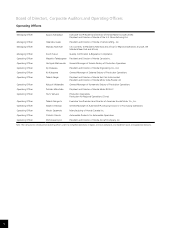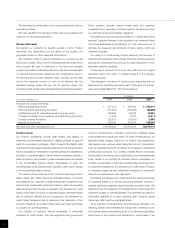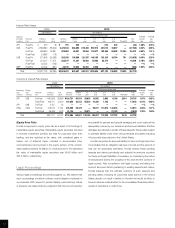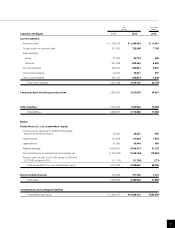Honda 2010 Annual Report Download - page 47
Download and view the complete annual report
Please find page 47 of the 2010 Honda annual report below. You can navigate through the pages in the report by either clicking on the pages listed below, or by using the keyword search tool below to find specific information within the annual report.
The trusts which were structured in North America in the fiscal year
ended March 31, 2010 did not meet the conditions to be a QSPE.
In addition, we deemed that the total equity investments of these
trusts at risk were not sufficient to finance their activities without
additional subordinated financial support provided by our finance
subsidiaries. Accordingly, we recognized these trusts as VIEs.
Furthermore, as the finance subsidiaries retain certain subordinated
interests of these trusts and it is expected that we would absorb the
majority of the expected losses of these trusts, we have consolidated
these trusts.
Guarantee
At March 31, 2010, we guaranteed ¥31.7 billion of employee bank
loans for their housing costs. If an employee defaults on his/her loan
payments, we are required to perform under the guarantee. The
undiscounted maximum amount of our obligation to make future
payments in the event of defaults is ¥31.7 billion. As of March 31,
2010, no amount was accrued for any estimated losses under the
obligations, as it was probable that the employees would be able to
make all scheduled payments.
and sell pools of these receivables. In these securitizations, our
finance subsidiaries sell a portfolio of finance receivables to a special-
purpose entity, which is established for the limited purpose of buying
and reselling finance receivables. Our finance subsidiaries remain as
a servicer of the finance receivables and are paid a servicing fee for
our services. The special-purpose entity transfers the receivables to
a trust which is newly structured for each securitization or bank
conduit, which issues asset-backed securities or commercial paper,
respectively, to investors. Our finance subsidiaries retain certain
subordinated interests in the sold receivables in the form of
subordinated certificates, servicing assets and residual interests in
certain cash reserves provided as credit enhancements for investors.
Our finance subsidiaries apply significant assumptions regarding
prepayments, credit losses and average interest rates in estimating
expected cash flows from the trust or bank conduit, which affect the
recoverability of our retained interests in the sold finance receivables.
We periodically evaluate these assumptions and adjust them, if
appropriate, to reflect the performance of the finance receivables.
We have not historically consolidated trusts since these trusts
meet the definitions of a qualifying special-purpose entity (QSPE).
Tabular Disclosure of Contractual Obligations
The following table shows our contractual obligations at March 31, 2010:
Yen (millions)
Payments due by period
At March 31, 2010 Total Less than 1 year 1-3 years 3-5 years After 5 years
Long-term debt ¥3,035,331 ¥ 722,296 ¥1,496,585 ¥730,820 ¥ 85,630
Operating leases 117,027 22,556 28,892 17,362 48,217
Purchase commitments*1 47,436 47,436 — — —
Interest payments*2 337,573 146,794 155,062 33,597 2,120
Contributions to defined benefit pension plans*3 81,544 81,544 — — —
Total ¥3,618,911 ¥1,020,626 ¥1,680,539 ¥781,779 ¥135,967
*1 Honda had commitments for purchases of property, plant and equipment at March 31, 2010.
*2 To estimate the schedule of interest payments, the Company utilized the balances and average interest rates of borrowings and debts and derivative instruments as of March 31, 2010.
*3 Since contributions beyond the next fiscal year are not currently determinable, contributions to defined benefit pension plans reflect only contributions expected for the next fiscal year.
If our estimates of unrecognized tax benefits and potential tax
benefits are not representative of actual outcomes, our consolidated
financial statements could be materially affected in the period of
settlement or when the statutes of limitations expire, as we treat
these events as discrete items in the period of resolution. Since it is
difficult to estimate actual payment in the future related to our
uncertain tax positions, unrecognized tax benefit totaling ¥109,473
million is not represented in the table above.
At March 31, 2010, we had no material capital lease obligations
or long-term liabilities reflected on our balance sheet under U.S.
GAAP other than those set forth in the table above.
Application of Critical Accounting Policies
Critical accounting policies are those which require us to apply the
most difficult, subjective or complex judgments, often requiring us to
make estimates about the effect of matters that are inherently
uncertain and which may change in subsequent periods, or for
which the use of different estimates that could have reasonably been
used in the current period would have had a material impact on the
presentation of our financial condition and results of operations. A
sustained loss of consumer confidence which may be caused by
continued economic slowdown, recession, changes in consumer
preferences, rising fuel prices, financial crisis or other factors have
combined to increase the uncertainty inherent in such estimates and
assumptions.
45
























